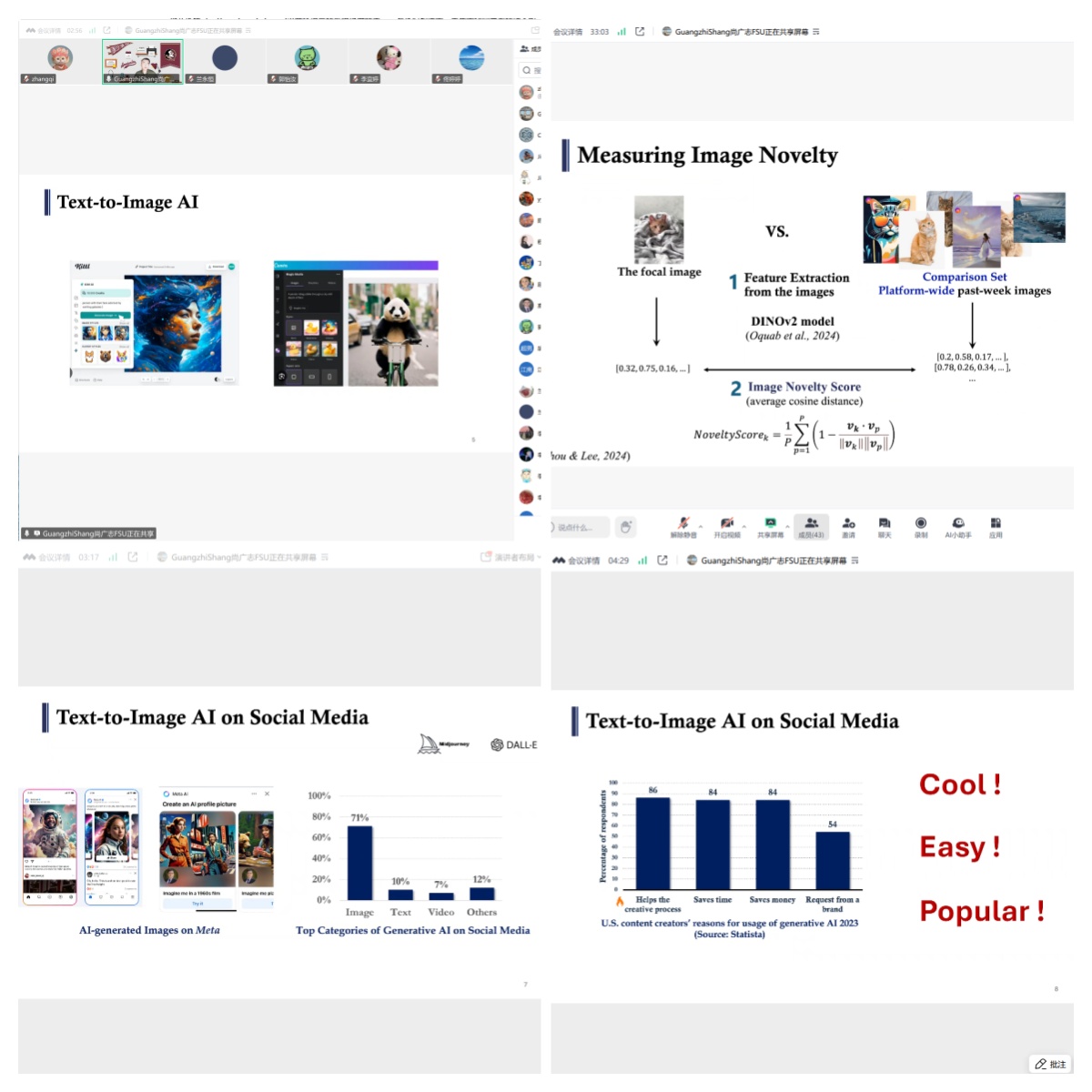
2025年6月10日上午,现代供应链管理研究院第117期学术论坛在腾讯会议线上如期举行。主讲人尚广志,佛罗里达州立大学运营管理系副教授。他的主要研究方向为消费者退货管理、服务劳工问题以及创新技术管理。报告题目为“Text-to-image AI and the Novelty of User Generated Content on Social Media”。

论坛上,尚广志教授就自己的研究成果向在场的与会人员进行了生动的汇报分享。他以深入浅出的方式,将文生图人工智能工具这一前沿科技在社交媒体领域的影响进行了全面剖析。从理论层面,他详细阐述了文生图人工智能工具如何赋予社交媒体用户将奇思妙想转化为多元视觉风格可视化内容的能力,为平台注入新的新颖性源泉,又巧妙地引出该工具对用户生成常规内容新颖性可能产生的溢出效应这一核心议题,并深入剖析了声誉机制与人工智能使用机制在这其中的潜在作用。整个汇报过程中,尚教授的讲解生动有趣、逻辑连贯,内容呈现色彩丰富,将复杂的学术研究转化为一场引人入胜的知识盛宴,激发了大家对文生图人工智能工具在社交媒体领域应用的深入思考。与会者们全神贯注,会后踊跃提问、积极交流,现场学术氛围热烈浓厚。未来,我院将持续致力于构建高质量的科研交流平台,为学者们提供更多的交流与合作机会,共同打开科研工作的新局面,助力学校工商管理一级学科建设并为学校的双一流建设注入新的活力。
【摘要】
Text-to-image AI tools enable social media users to transform their imaginative ideas into visual content in a wide range of visual styles, adding a new source of novelty for social media platforms. We argue that the AI tools also pose a spillover effect on the novelty of user-generated regular content on social media (i.e., content generated without an AI tool) because using AI tools could potentially change the reputation dynamics on social media platforms (i.e., reputation mechanism) and/or fundamentally reshape human cognitive processes and innovative thinking (i.e., AI-usage mechanism). Collaborating with an image-sharing social media platform, we employ a difference-in-differences (DID) approach to empirically demonstrate that using a text-to-image AI tool significantly reduces the novelty of user-generated regular images. That is, after using the text-to-image AI tool, AI users’ regular images become more similar to the platform-wide recent images than those of non-AI users. We do not find evidence supporting the reputation mechanism. However, empirical evidence consistently validates the AI-usage mechanism. Specifically, novelty reduction worsens with more frequent AI usage, and frequent AI generation induces a fixation effect evidenced by users’ conformity to AI, i.e., regular images from AI users become more similar to the AI-generated images than those from non-AI users. Delving into more granular image-level generation records, we conduct an instrumental variable analysis and find that repeatedly generating AI images in a specific style reinforces user perception of a strong prototype and intensifies the fixation effect, leading to greater conformity of their regular images to that AI style. Finally, prompt input plays a key role in shaping the AI-induced fixation effect on the novelty of regular content. AI users who consistently input prompts with broader informational scope and greater semantic variation are less subject to novelty reduction of regular content.
【报告人简介】
Guangzhi Shang is Jim Moran Associate Professor of Operations Management in the Department of Business Analytics, Information Systems, and Supply Chain at Florida State University. His research has been published in Manufacturing & Service Operations Management (MSOM), Management Information Systems Quarterly (MISQ), Production and Operations Management (POM), Journal of Operations Management (JOM), and Decision Sciences (DS), among others, and recognized by best paper awards at POM, JOM, and POM Society’s College of Operational Excellence. He serves as the co-Department-Editor for the Empirical Research Methods Department at JOM and for the Retail Operations Department at DS. His review service is recognized by the 2019 outstanding reviewer award of DS and the 2018 best reviewer award of the Journal of Operations Management. He was also nominated for the best reviewer for POM and best associate editor for JOM. He co-produces a column together with Mike Galbreth and Mark Ferguson in the Reverse Logistics Magazine named “View from Academia,” aimed at disseminating fresh-off-the-press academic knowledge among industry professionals dealing with consumer returns.
Guangzhi Shang’s current research has three primary themes: consumer returns management, service labor issues, and management of innovative technologies. He investigates the first from a variety of angles, including how a retailer should set its optimal return policy, how an OEM or a retailer could better forecast the quantity of returns, and how a retailer could assess the value of its return policy. For the second, he focuses on the context of live-chat contact centers. Research questions include the impact of customer’s waiting experience on the progress of a chat session, agent’s ability to learn from their past experiences, and the customer–agent matching problem. For the third, he looks into emerging fintech such as cryptocurrency and crowdfunding platforms. He enjoys doing practice-driven research. He is a frequent invited speaker at leading industry conferences such as the annual Consumer Returns conference.





